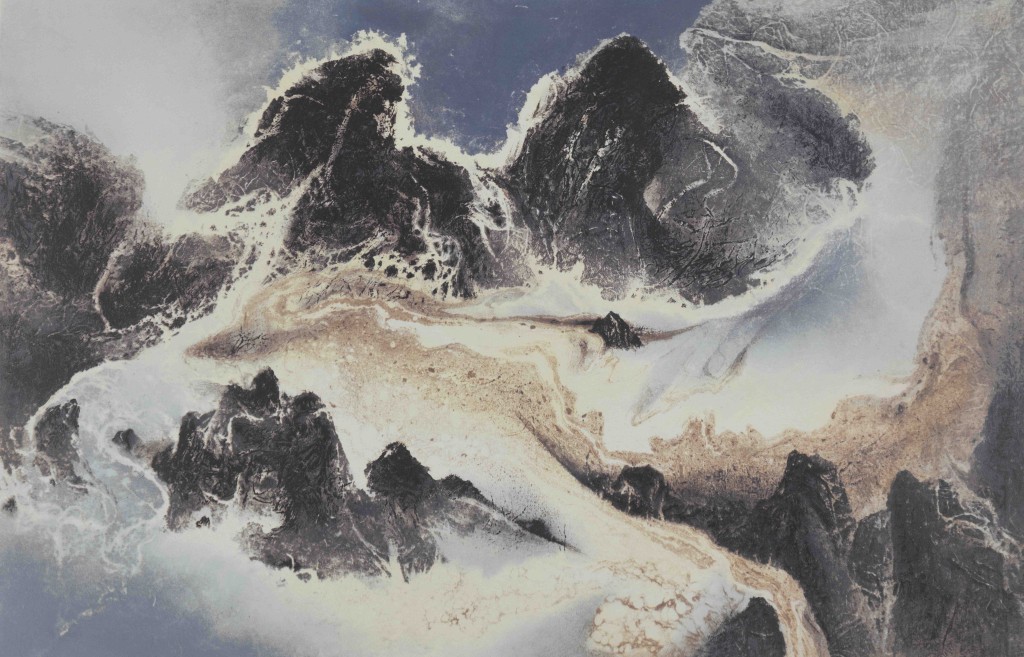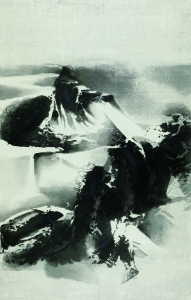印製劉國松版畫的使命
文/劉素玉
在兩岸藝術界,年逾八十的劉國松被尊稱為「水墨現代化之父」,然而他還有一個有趣的封號:現代水墨傳教士。劉國松當年創辦「五月畫會」時,他的夫人黎模華形容他宛如「傳教士」,因為他推動現代水墨的熱情無與倫比,簡直就像狂熱的宗教領袖,無時無刻到處宣揚,即使受到他人冷落、揶揄,甚至唱反調,也不以為意。劉國松雖然不是教徒,也不隨時捧讀聖經,對於這個其實是有點調侃他的封號卻欣然接受,「現代水墨傳教士」一名自此不逕而走。
劉國松信仰的是藝術,現代水墨畫就是他的聖經,一個甲子以來,他拿著他的聖經在世界各地行走,不但教人畫畫,也到處舉辦展覽,當年一頭濃密黑髮的青年,如今已是白髮稀疏的八旬老翁,他對現代水墨畫的熱情依舊不減,只是與一個甲子之前不同的是,當年他被罵「藝術的叛徒」1,即使有「五月畫會」同志支援,但與深厚的傳統國畫和龐大的摩登西畫勢力相較,他無疑勢單力薄。如今時勢不同了,現代水墨畫邁入新世紀以來,漸漸方興未艾,近兩、三年來更是欣欣向榮,劉國松的作品突然也在畫畫市場上炙手可熱,其實他的作品過去一向在全球各地廣受喜愛,全球超過七十個公立美術機構典藏他的作品,應是當今被最多被國際美術機構收藏作品的華人藝術家,但在書畫市場上卻並未特別受到國人青睞,直到近一、兩年來才有明顯變化。

1956年劉國松發起成立五月畫會,這是台灣第一個現代藝術畫會,其所要面對的,不只是當年時髦的西洋畫派,還有保守的國畫畫派,這兩大陣營都有大批人馬,聲勢浩大,以劉國松為首的五月畫會,左批崇尚印象畫路線的西洋畫派,右砍死抱舊傳統不放的國畫派,他英勇地向兩大勢力開戰:「我們既非古時之中國人,亦非現代的西洋人。」2同時也遭受兩面勢力的無情夾擊,他一面畫畫,一面執筆,畫畫實踐自己的藝術理念,執筆論述釐清自己的理論架構,同時也反駁不同的藝術思潮,這常使他深陷背腹受敵的險境,而面對險境,他永遠都像是右手拿寶劍,左手拿聖經的信徒,義無反顧的往前衝,從不退縮。
除了自己畫畫,劉國松也到處教人畫畫,不只是在校園裡、課堂裡,也擴及社會各界,他任教於香港中文大學時,便首創「現代水墨畫」課程和校外進修部成立了「現代水墨研習班」;除此之外,他在各地舉行藝術展覽之際,也同時展開演講,甚至親自公開技法展示及教學示範,1983年他接受當時中國美術家協會主席江豐之邀到北京中國美術館舉行個展,並於中央美術學院公開演講,隨後巡迴展於南京、廣州、武漢、哈爾濱、上海等美術館,隨後三年共巡迴展出十八個城市,並均作多場演講,每一次的展覽及演講,無不渾身解數宣揚現代水墨畫,在當年閉鎖的中國藝壇裡,他的展覽與演講激起無數漣漪,數不清有多少後進受到啟發,一頭栽進現代水墨的創作潮流。
劉國松常常對學生說:「繪畫是不停的實驗」3,而他本人也身體力行。綜觀他創作半個世紀以來,繪畫實驗從未間斷。但凡能在美術史上成為一家者,皆必須有個人獨特的創造,劉國松的實驗無非就是追求創新,早年他大膽地揚棄筆和墨,甘冒大不韙地大聲疾呼「革筆的命、革中鋒的命」,他要求學生由「一隻筆走天下」的文人畫家「筆墨論」一言堂的封建思想中解放出來4,他親力親為,把自己創新的技法教給學生,並要求學生拋開所有包袱,他主張「先求異,再求好」5,也以陳其寬和余承堯都沒有臨過古畫,也沒有畫過文人畫,都沒有所謂的中國傳統繪畫的基礎和基本功,卻畫出個人獨特風格,並受到國際畫壇的重視與肯定,來鼓勵後進以實際行動反叛文人狹隘的筆墨論。
劉國松其實從小就學習傳統國畫,但後來卻能果敢地捨棄,他也寫得一手好毛筆字,卻鮮少公開展現,在一些公開場合,頂多「畫字」6。他力行「筆墨無用論」,開創了「抽筋剝皮皴」、「水拓法」、「漬墨法」…,連紙張都加以革新,開發了佈滿粗紙筋的棉紙-即後來被美術史家所稱的「劉國松紙」。他大半生不遺餘力地啟發觀念,掙脫傳統束縛,作育英才無數,他不僅是一位藝術家,更是一位藝術思想推廣家。而他的行動力強,自發起五月畫會以來,凡畫會展覽出錢出力,絕不藏私,為了壯大現代水墨隊伍,更總是熱心召集畫友、學生,到處舉行聯展,近年來更多次組織「白線的張力」巡迴展、「劉國松師生展」,在全世界巡展,以個人資源獎掖志同道和與門生後進,任勞任怨且任謗,這樣的付出與執著豈止像虔誠的教徒,根本就是狂熱的傳教士。

《雲水一家》Water and Cloud Share the Same Source
絲網 Silkscreen (版數 Edition of 100)
2014, 65 x 100 cm
筆者與劉國松相交長達十年以上,有幸成為他的傳記作者,在2007年出版《宇宙即我心-劉國松的藝術創作之路》7,及至成立高士畫廊,進一步經紀他的作品,在此期間,深感喜愛劉國松作品的人士愈來愈多,尤其近兩年來,其市場價格一飛沖天,原作更是一畫難求,為了推廣劉國松的藝術,決定製作版畫,版畫就如同傳教士的聖經,傳教士的聖經要多多益善,然此「聖經」畢竟是劉國松藝術的衍生,因此除了數量之外,更嚴格要求品質精美,以及接近原作特色。這個理念得到劉國松的認可,更得到虛苑國際版畫中心主人姜興道的大力支持,他以罕見的魄力,一聲令下,號召虛苑三十多位資優技師,全力投入劉國松版畫的製作行列。在經過與專業技師充分討論之下,挑選了木刻水印、銅版、絲網等三個版種,分別製作劉國松的九件精彩原作,這些原作早已為國際知名美術機構典藏,或落入重要收藏家之手,連劉國松本人都難以親見,例如英國倫敦大英博物館典藏的《日月浮沈》、美國哈佛大學美術館典藏的《寒山雪霽》與《雲水一家》、美國舊金山亞洲藝術博物館典藏的《世界屋脊》、香港藝術館典藏的《雲樹銀枝》…,除此之外,九件原作也分別是最能呈現劉國松技法,在他創作歷程中最具代表性的神品,其中部份作品更已被收錄入各大重要美術史冊。
選擇以不同的版種來呈現原作的風格與特色,需要相當厚實的經驗、老到的技術,以及充分的美學素養,因為不論木刻水印、銅版、絲網版畫,都是重新製版,再一次次分版、上色,等同於二次創作,而又受到必須忠於現原作特色的限制,其製作艱辛程度著實不下於原作創作。虛苑主人姜興道十分欣賞劉國松的作品,更肯定劉國松終生推動現代水墨畫的努力,或許也受到這位現代水墨傳教士精神感召,因此不惜以最大的心血,甚至不惜血本,製作一批前所未有的版畫,例如以銅版製作1米乘2米的《雲樹銀枝》,銅版製作本來就耗時費力,成本高昂,光是鐫刻大型銅版就花了將近兩個月時間,印製過程也極耗功夫,這件堪稱亞洲已知最大的銅版畫,連劉國松本人看了都瞠目結舌,贊不絕口,更重要的是,它雕刻細緻,線條生動,完全能呈現原作崇山峻嶺之中雪花飄揚的動感與浪漫詩意;即使是絲網製作的《藍色光波》,都能呈現豐富多姿的色彩,其層次感與光波流動感栩栩如生,劉國松看了不禁豎起大姆指說:「(世界屋脊版畫)比我的原作更氣派,(藍色波光版畫)比我的原作更漂亮!」

《世界屋脊》Roof of the World
木刻水印 Woodblock Print (版數 Edition of 100)
2014, 100 x 201 cm
誰也沒有想到,當年劉國松夫人幾近調侃劉國松的「傳教士」封號,跟隨劉國松已逾一甲子,誠然所謂知夫莫若妻,然而最重要的是,劉國松孜孜不倦宣揚現代水墨畫,終生奉行不渝,若沒有教徒的虔誠以及堅定的信仰,何以至此?現代水墨畫如今終於受到世人肯定,劉國松的作品更受到眾人追捧而一畫難求,這批能忠實呈現劉國松原作精髓,並獲得他大力讚賞的版畫,將會是他繼續傳播現代水墨藝術的聖經。
1. 1965年劉國松在《文星》雜誌上發表的<中國現代畫的路>自述:「保守者常稱我等為『藝術的叛徒』。」在守舊勢力龐大的時代,這是大扣帽子,為此他也付出相當代價,包括無法任教於國立大學美術科系。
2. 1965年劉國松在《文星》雜誌上發表的<中國現代畫的路>就大力抨擊:「傳統的『皴』早已變成僵硬的『地龍乾』(曬乾的蚯蚓),固有的形式(如山水、人物、翎毛、花卉)早已變成了封閉的枯井,毫無生命之可言。因此,我一定要送他進殯儀館(而不是博物館)。一味跟隨西洋現代風格形式,亦失去自己,我們既非古時之中國人,於非現代的西洋人,我們既非生活在宋元的社會,亦非生活在歐美的環境,我們抄襲古畫就是作偽,畫西洋現代畫又何嘗不是?」。
3. 1996年劉國松在《美育月刊》發表<談水墨畫的創作與教學>說:「作為一個畫家與作為一個科學家沒有什麼兩樣,……。畫家也是一樣,他必須全心全意地在畫室中不停的實驗,實驗成功了才有所創造,有所創造才能成其為畫家。」
4. 1999年劉國松發表<二十一世紀東方繪畫的新展望>於《二十一世紀視覺藝術新展望國際學術研討會論文集》提到,要學生「走出筆墨論的一言堂」。
5. 見於1999年劉國松發表的<先求異再求好-從事美術教育四十年的一點體悟>。
6. 劉國松為了貫徹反筆墨的理念,所以不寫書法,但在公開場合應眾人要求,他用大筆觸入畫,稱為「畫字」。
7. 《宇宙即我心-劉國松的藝術創作之路》,張孟起、劉素玉合著,典藏藝術家庭股份有限公司於2007年4月出版。
The Scripture of the Missionary of Modern Ink Painting
- The Mission of Creating Liu Kuo-sung’s Prints
In the art worlds of Taiwan and China, Liu Kuo-sung (b. 1932) has been crowned the Father of Modern Ink Painting. However, Liu also holds another title; the Missionary of Modern Ink Painting. When Liu Kuo-sung founded the Fifth Moon Group in 1956, his wife Li Mo-hua described him as a missionary, due to his passion in promoting modern ink painting, with an almost religious zeal wherever he went. Even in the face of criticism or ridicule, Liu’s passion in the new genre never swayed. Although Liu is not religious, nor does he read the Bible, he gladly accepts the title of a missionary, and fully lives up to it, as a true missionary of modern ink painting.
Liu Kuo-sung’s faith is art, and modern ink paintings are his scripture. Over the last sixty years, Liu has spread word of his scripture around the world, showing his paintings in art exhibitions and discussing his art in academic seminars. From years of youth to this day in old age, Liu’s passion for modern ink painting has remained just as strong. What has changed is that Liu Kuo-sung is no longer slandered as a traitor to art.1 Due greatly to Liu’s efforts, the art world of Taiwan and China is no longer dominated by conservatives of traditional Chinese ink painting, and have gradually come to embrace modernism as a necessary development to ink painting. In terms of international recognition, Liu Kuo-sung’s artworks have entered public collections of over seventy museums and academic institutions worldwide. However, in the last several years, have they also entered the spotlight of the art market, and have since become extremely sought after.
When the Fifth Moon Group was founded in 1956, it was Taiwan’s first art group to specialize in modern ink painting. The group faced the duel challenges of Western painting and traditional Chinese ink painting, both of which were strong and popular movements. On one hand, Western painting, in imitation of the Impressionists, was considered fashionable among the young and educated. While on the other, conservatives, especially in academia, desperately called for the revival of traditional Chinese ink painting in the classical manner. Unsatisfied with the two extremes, Liu Kuo-sung boldly stated: “we are neither Chinese living in classical times, nor are we Westerners.”2 Despite suffering attacks and criticism from both sides, Liu continued down his chosen path to paint and write on modern ink; experimenting with new techniques of ink and wash, as well as publishing articles on his findings and beliefs. Comparable to a missionary, Liu Kuo-sung holds his scripture in one hand, and a sword in the other.

In addition to his own painting, Liu Kuo-sung is also passionate about teaching others how to paint. During his term as professor at the Chinese University of Hong Kong, Liu created the Modern Ink and Wash Painting course for enrolled students, and also with the help of the extension school, created the Modern Ink and Wash Painting Diploma course, available to the general public. Also, in his exhibitions, Liu often demonstrates his own painting techniques, as a performance to further promote the new genre. In 1983 Liu was invited by Jiang Feng, the chairman of the Chinese Artists’ Association, for a solo exhibition at the National Art Museum of China in Beijing, and to give a series of lectures starting at the China Central Academy of Fine Arts. Over the next three years, Liu toured in eighteen cities throughout China, in numerous exhibitions and seminars, bringing modern ink painting to the long isolated Chinese art world.
Liu Kuo-sung often tells his students: “the art of painting is to constantly experiment,”3 and does exactly that himself. By examining Liu’s long journey of artistic creation, and the various innovations throughout his art, it is evident his spirit of experimentation has never diminished. In order to secure a rightful place in the history of art, an artist must have an unique and personal style. In retrospect, Liu Kuo-sung’s art is nothing less than the constant pursuit for innovation. During Liu’s early years, he discarded all traditional Chinese conventions of the brush, and boldly exclaimed to “revolutionize the brush.”4 He has since urged his students to rethink how they hold and execute the brush, and to personalize their painting instruments according to their own needs. In terms of style, Liu advocates to “first strive for individuality, then strive for perfection.”5 Liu deeply admires Taiwanese artists Chen Chi-kwan (1921 – 2009) and Yu Cheng-yao (1898 – 1993), both of whom have never trained in the classical Chinese tradition, but have nonetheless developed their own styles in ink painting, and have received international recognition for doing so. Their success serve as an inspiration to Liu’s students, as well as himself.

《藍色光波》Blue Light on the Ripples
絲網 Silkscreen (版數 Edition of 100)
2014, 67 x 90 cm
In fact, Liu Kuo-sung childhood was immersed in traditional Chinese ink painting, which he grew to renounce as an adult. Despite being well-trained in the art of calligraphy, Liu rarely displays this talent in public. He sees past the limitations of brush and ink in themselves, and has experimented with unconventional methods of applying ink onto paper. His success can be seen in his renowned techniques of water-rubbing and steeped ink. Through trial and error with different variations of rice paper, Liu has created his own paper with very dense fibers, which has been coined by art historians as Liu Kuo-sung Paper. What is truly remarkable about Liu’s innovations is his enthusiasm in sharing them with everyone, selflessly announcing his findings and techniques in public seminars and demonstrations. Since the days of the Fifth Moon Group, Liu has helped and sponsored countless artists and friends in scholarships and exhibitions. In recent years, Liu organized the Tension of White Line group exhibitions for his students to tour in museums across Taiwan and China. In this way, Liu Kuo-sung is not only an artist, but also an educator. He is a man on a mission – a mission to promote modern ink painting.
I have had the pleasure of knowing Liu Kuo-sung for over a decade, and the honor of co-authoring his biography, Universe in My Mind – the Artistic Journey of Liu Kuo-sung, published in 2007. Since opening Loftyart Gallery in 2012, and further managing Liu’s career, serious collectors in Taiwan and China have become very attuned to Liu’s paintings on the art market. Especially in the past several years, his paintings have become increasingly sought after, and in response their market value have skyrocketed. In order to continue promoting Liu’s art, Loftyart has decided to assist Liu in creating a series of prints. To the missionary, that is Liu Kuo-sung, prints are his scripture, to be made available for wide admiration and to reflect on his faith in modern ink painting. This statement is recognized by Liu himself, and also strongly supported by Jiang Xingdao, the founder and manager of Xuyuan International Print Centre in Beijing. With great enthusiasm, Jiang has organized a dedicated team of over thirty printers for the project, and together with Loftyart, carefully selected nine of Liu Kuo-sung’s most representative paintings as inspirations for the prints. In examining the unique qualities of each painting, Xuyuan and Loftyart have chosen three types of prints, woodblock, etching, and silkscreen, to fully represent the diverse variety of Liu’s art. The nine paintings themselves, being defining works in Liu’s career as well as modern Chinese art history, have all entered renowned museums or important private collections, such as Sun and Moon: Floating? Sinking? in the British Museum, Wintry Mountains Covered with Snow and Water and Cloud Share the Same Source in the Harvard Art Museums, and Roof of the World in the Asia Art Museum of San Francisco.

《雲樹銀枝》Sun and Silvery Woods Amidst Cloudy Mountains
銅版 Etching Print (版數 Edition of 100)
2014, 100 x 200 cm
Xuyuan’s team of printers have demonstrated considerable knowledge, technical skill, and aesthetic accomplishment in creating Liu Kuo-sung’s prints. As each board is individually carved, etched, or drawn, and later printed with multiple runs, the prints are truly works of art in themselves At the same time, through Liu Kuo-sung’s kind guidance, they remain faithful to their original inspirations. Xuyuan’s manager Jiang Xingdao deeply admires Liu Kuo-sung for his art, as well as his contributions to modern ink painting. As a print specialist, Jiang is determined to use this opportunity to challenge the boundaries of printing in China. For the monumental etching Silvery Woods Amidst Cloudy Mountains, which measures one meter in height and two meters in length, Jiang had the oversized copper plate and acid pool custom made for the project. Etching the plate alone was a lengthy two month process. However, the printed result is unprecedented and phenomenal. Jiang is confident it is the largest etching ever produced in China. Liu was delighted by the vivid textures created by the etching needle and its effective representation of the harsh winter landscape. Moreover, Liu was so pleased with how the colors were rendered on the silkscreen Blue Light on the Ripples, he wholeheartedly told the printers: “this is prettier than my original painting!”
No one would have thought Li Mo-hua’s joking description of her husband as a missionary would become Liu Kuo-sung’s title for the next sixty years. Through Liu Kuo-sung’s selfless dedication and faith in modern ink painting, he has amassed a legion of followers to his cause. Modernism has finally been recognized as a necessary development to ink painting, and Liu’s artworks have received their due attention on the art market. In faithfully representing Liu Kuo-sung’s most defining artworks, and earning his esteem in the process, this series of prints will ultimately become the scripture Liu needs to carry on his lifelong mission of promoting modern ink painting.
Elaine Suyu Liu
Translated by Timothy Chang
1. The Way of Chinese Modern Painting” Literary Star, 1964.
2. Ibid.
3. Liu Kuo-sung “On Creating and Teaching Ink Painting” Journal of Art Education, 1996.
4. Liu Kuo-sung “21 Century New Visions of Oriental Art” 21 Century New Visions of Visual Art International Symposium, 1999.
5. Liu Kuo-sung “First Individuality, then Quality” Forty Years of Art Teaching, 1999.
